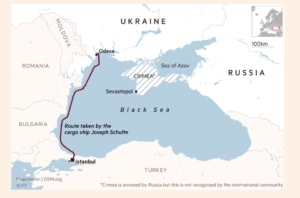The USDA is projecting that the ag trade deficit will shrink in FY2026 even more than previously anticipated. USDA expects the trade deficit to fall from $43.7 billion in FY2025…
Kyiv Finalizing Deal With Insurers to Cover Black Sea Grain Ships, While Additional Heavy Rain Expected in China
Over the weekend, Bloomberg writers Aine Quinn and Olesia Safronova reported that, “The Kremlin’s efforts to paralyze Ukrainian food shipments are succeeding, with a third of the country’s crop exports wiped out since its Black Sea ports were effectively blocked last month.
“The drop marks a significant setback for Ukraine’s economy and global food security, even with a €1-billion push by the European Union to build out alternative routes since the start of Russia’s invasion. The US this week said it’s working with European partners to keep grain exports flowing, relying on rivers like the Danube and other avenues after sea passage has become unsafe.

“‘The key question is the river ports,’ said Evghenia Sleptsova, senior economist at Oxford Economics. But ramping up volumes through those could prove difficult ‘now Russia started bombing Izmail and Reni,’ two ports along the Danube which were attacked earlier this week.”
.@StateDeputySpox on Russia’s continued attacks on Ukrainian grain infrastructure: This further escalates the global food crisis, and it keeps food prices high.
— Department of State (@StateDept) August 16, 2023
Our Ukrainian partners are inspiring the world while Russia starves it by weaponizing food. pic.twitter.com/T4MCR1OTgw
The Bloomberg writers explained that, “Ukraine was only able to export 3.2 million tons of grains, vegetable oils and meals in the four weeks through August 15, down from 4.4 and 4.8 million tons in May and June when the Black Sea deal was still in place, according to estimates from analyst UkrAgroConsult.
Crop stockpiles are now expected to swell through next year as better-than-expected harvests face fewer routes to market.
However on Friday, Financial Times writer Isobel Koshiw reported that, “The passage of a cargo ship from Ukraine to Turkey this week vindicated Kyiv’s gamble that Russia would not act on threats to attack commercial shipping in the Black Sea.

“But the successful gambit leaves a bigger question for Ukraine: will any other commercial vessels follow the Joseph Schulte and dare to call Russia’s bluff?
“The German/Chinese-owned cargo ship was the first vessel to make the journey out of Ukrainian waters since July, when Russia warned it would consider any civilian vessel leaving Ukraine’s ports as military targets.”
The FT article noted that, “Despite the Joseph Schulte’s successful journey, major shipping groups and exporters remain wary of travelling through the Black Sea.”
And yesterday, Financial Times writers Ian Smith and Isobel Koshiw reported that,
Ukraine is finalising a scheme with global insurers to cover grain ships travelling to and from its Black Sea ports, a vital step in the country’s attempts to create a safe corridor for exports after Russia withdrew from a UN-brokered deal last month.
“Oleksandr Gryban, special envoy for Ukraine’s economy ministry, told the Financial Times that the deal was ‘currently being pursued and actively discussed‘ between the relevant ministries, as well as local banks and international insurance groups including Lloyd’s of London.
“The scheme could be put in place as early as next month, and could see as many as five to 30 ships covered to travel through what he described as the ‘danger spot’ of Ukrainian waters.”
Reuters writer Pavel Polityuk reported today that, “Ukraine is considering using its newly-tested wartime Black Sea export corridor for grain shipments after other cargo ships follow the first successful evacuation of a vessel on the route last week, a senior agricultural official said on Monday.”
Late last week, Reuters writer Luiza Ilie reported that, “Roughly 60% of Ukraine’s grain exports could transit through neighbouring Romania after Russia quit a U.N.-brokered safe passage deal through the Black Sea, Romanian Prime Minister Marcel Ciolacu said on Friday.”
Elsewhere, Bloomberg writer Hallie Gu reported today that, “China’s northeastern grain basket is bracing for another deluge of heavy rain, heaping more pain on farmers in the region who have already seen fields flooded and crops damaged by wild weather this month.
“Heavy rains are expected in some areas over Monday and Tuesday, and there’s a high risk of flooding in parts of Heilongjiang and Jilin provinces, according to the National Meteorological Center. That could inundate corn and soybeans and impact crop growth, the weather agency said on its website.”
Meanwhile, Reuters writer Naveen Thukral reported today that, “Chicago soybeans rose 1.5% to on Monday, climbing to their highest levels in more than three weeks, while corn gained more ground as concerns over hot and dry weather conditions in the U.S. Midwest buoyed agricultural markets.”
All Hazards Map... Corn Belt, Southern Plains Heat pic.twitter.com/Tb4EaG6SFn
— FarmPolicy (@FarmPolicy) August 21, 2023
7-Day Total Precipitation Outlook, Aug. 21st - 28th. pic.twitter.com/9Gw8J6wFsp
— FarmPolicy (@FarmPolicy) August 20, 2023
Also today, Bloomberg writer Megan Durisin reported that, “Soybean futures rose to the highest since July in Chicago as hot weather grips the US growing region, raising concerns about crops.”

The Bloomberg article indicated that, “The ‘heat dome‘ could last for more than a week and is boosting crop prices, Paris-based adviser Agritel said in a note. The weather is a particular concern for soybeans, as they are still in a crucial development phase — while most corn has finished pollinating.”





